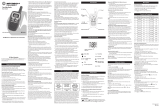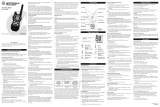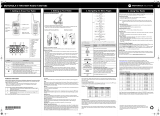
Date : Jan 14, 2011
Model : MS350R
Description : Line Arts for User Guide
For maximum clarity, hold the radio two to three inches away
from your mouth and speak directly into the microphone. Do not
cover the microphone while talking.
Talk Range
This radio is designed to maximize performance and improve
transmission range. Do not use the radios closer than five feet
apart.
Power Boost
To boost the radio’s power up to high power, press the top portion
of the button when talking. If you know your party is close by,
you can conserve the battery’s energy by pushing the lower part
of the button to use less power.
Note:
If you are on an FRS only channel (see “Channels and
Frequencies” tables on overleaf for details) the radio will only use
low power when either portion of the is pressed.
Monitor Button
Use the Monitor function to check if a channel is currently in use
by others. For maximum range performance, the Monitor
function will also help you to hear signals that are weak.
To latch the Monitor function on, Press and hold for three
seconds. When an empty channel is located, you will hear
continuous static and noise on that channel.
To turn the Monitor function off, tap a second time or press .
Push to Talk Timeout Timer
To prevent accidental transmissions and save battery life, the
radio emits a continuous warning tone and stops transmitting if
you press for 60 continuous seconds.
Menu Options
There are 12 options you may set to your preferences. Each press
of the MENU key advances you to the next option setting. Press
the or keys to change the setting. The menu will
automatically close 5 seconds after the last press of any button.
After the last menu item, the radio exits MENU mode and returns
to operation of the radio. A press of the button while setting
any menu option will immediately save all your settings and return
to operation of the radio.
All MENU settings will revert back to the factory default values if the
battery is fully discharged or removed for more than 30 seconds.
Menus and Values
1. Channel (1-22 and 15R-22R)
2. Interference Eliminator Code (1-121 or OFF)
3. Call Tone (1-10 or OFF)
4. iVOX (ON/OFF)
5. VOX sensitivity (1-3)
6. QT Noise Filtering (ON/OFF)
7. VibraCall (ON/OFF)
8. Keypad Tones (ON/OFF)
9. Talk Confirmation Tone (ON/OFF)
10. Auto Power Off (30/60/90 minutes or OFF)
11. Repeater Channel Enable (ON/OFF)
12. Repeater Transmitted Interference Eliminator Code
Selecting the Channel
This radio has 22 simplex channels plus 8 repeater duplex
channels. Channels are shared by other radio users and channel
selection will vary based on your location. Select a channel that is
not being used from the 22 available simplex channels. Channels
8-14 are low power (FRS 0.5 watt). All other channels are GMRS.
When the radio is on a FRS 0.5 watt channel, displays. When
the radio is on a GMRS 1.5 watt channel, displays.
The 8 GMRS repeater duplex channels 15R – 22R are disabled
by default. See ”Enabling Repeater Channels” on overleaf in
order to select a repeater channel.
See the “Channels and Frequencies” tables on overleaf for
details on channel frequencies.
1. Press . The current channel setting flashes.
2. Press or and select the channel.
3. Press to save the channel setting or to continue set up.
Selecting the Interference Eliminator Code
This radio has 121 Interference Eliminator Code settings. When a
channel is in use by 2 or more groups, this feature blocks the
reception of signals that do not carry the matching tone or code.
There are 121 privacy codes. 0 is the off position, no codes are
enabled, and all users of that channel will be heard.
Note: When you connect a headset, the radio is automatically
set to the last chosen sensitivity level.
Q
T
Noise Filtering
The Q
T
noise-filtering feature helps to ensure uninterrupted
communication with other Motorola radios that have this
feature. This feature also filters out unwanted transmissions
from other radios. This is useful in places where there is
heavy radio traffic, such as amusement parks or ski resorts.
Note: Q
T
noise filtering is not available when the radio is
scanning.
To turn Q
T
noise filtering on or off:
1. Press until displays. The current setting On/Off
will flash.
2. Press or to turn noise filtering On or Off.
3. Press to confirm your selection or to continue
set up.
To transmit to a radio that has Q
T
noise filtering turned on:
1. Select the same channel and Interference Eliminator
Code as the other radio.
2. Press to send a call tone. This allows your voice to
pass through the Q
T
noise filter on the receiving radio.
3. Press and speak normally.
Note: If you skip step 2, the beginning of your message may
not be heard on the receiving radio. For a 30-second period,
starting after the last transmission, all transmissions
received on the selected channel and code will pass
through the Q
T
noise filter.
VibraCall
TM
Alert
VibraCall
TM
is a vibrating alert that notifies that the radio is
receiving a message. This is useful in noisy environments. When
the alert is on, the radio vibrates once every 30 seconds when
you receive a message on the channel and code you set.
1. To turn vibrating alerts on, press until is displayed. The
current setting will flash.
2. Press or to change the setting to On/Off.
3. Press to set or to continue set up.
Keypad Tones
You may enable or disable the speaker key tones. You will hear
the key tone each time a button is pushed.
1. Press until appears. The current setting On/Off will flash.
2. Press either or to turn On or Off.
3. Press to confirm or to continue set up.
Note: When the key tone feature is off, the following are not disabled:
• Transmit timeout alert tone
• Call tone
• Low battery alert tone or
• The transmitted talk confirmation tone
Transmitting a Talk Confirmation Tone
You can set this radio to transmit a unique tone when you finish
transmitting. It is like saying “Roger” or “Over” to let others
know you are finished talking. Talk Confirmation Tone is disabled
in repeater mode on channels 15R-22R.
1. Press until the appears. The current setting On/Off
flashes.
2. Press or to turn On or Off.
3. Press to set or to continue setup.
Auto Power Off
Your radio will save power by automatically turning itself off if
unused after a predetermined amount of time.
1. Press until displays. The current setting (0, 30, 60 or 90)
will flash.
2. Press or to set the time to 30 minutes, 60 minutes or
90 minutes. When this feature is activated, the will remain
on the display.
3. When you exit the Menu mode, the timer will begin. If a
button is pressed, or if there is an incoming signal, the timer
will restart.
4. Press to confirm or to continue set up.
Enabling Repeater Channels
Use of a repeater can greatly increase the radio range and
coverage area. Repeater use must be coordinated with the
owner of the repeater. Be sure to understand and follow the
sharing and usage rules for each repeater system.
Date : Jan 14, 2011
Model : MS350R
Description : Line Arts for User Guide
Date : Jan 14, 2011
Model : MS350R
Description : Line Arts for User Guide
See the ”Interference Eliminator Tone / Code Values” table on
overleaf for details on tone frequencies and code values.
1. Press until the code starts to flash.
2. Press or to select the code.
3. Press to save the code setting or to continue set up.
You can set a different code for each channel using this
procedure. An extended press of or allows you to scroll
rapidly so you can quickly reach the code you want.
This menu setting for repeater channels 15R-22R is used for
receiving only. The value must match with the repeater output.
Many repeaters will require a value of 0 or OFF. The transmitted
code is set separately and is often required for repeater access.
See ”Selecting the Repeater Access (TX) Code” on overleaf for
additional information.
Note: You must set the Interference Eliminator Code to 0 to
communicate with radios that do not have Interference
Eliminator Codes.
Setting and Transmitting Call Tones
This radio can transmit different call tones to other radios in your
group so you can alert them that you want to talk. The radio has
10 call tones from which to choose.
To set a call tone:
1. Press until the current call tone setting flashes and
appears.
2. Press or to change and hear the call tone.
3. Press to set the new call tone or to continue set up.
To transmit your call tone to other radios set to the same
channel and Interference Eliminator Code as your radio,
press .
Note: Setting the call tone to 0 disables the call tone feature.
Hands-Free Use Without Accessories ( )
You can use the iVOX feature to transmit hands-free without the
need for any headset accessories. Once iVOX is turned on, the
radio detects your voice and transmits when you speak into the
internal microphone.
1. Press until appears on the display. The current
setting On/Off will flash.
2. Press or to select On or Off.
3. Press to set or to continue set up.
Hands-Free Use With Accessories ( )
You can transmit hands-free more reliably with the use of
optional headset accessories. Once VOX is turned on, the radio
detects your voice and transmits when you speak.
Many accessories (sold separately) are available for this radio. For
more information, visit our Web site at www.motorola.com or
shop.giantintl.com.
1. Turn the radio off and plug the VOX accessory into the
accessory port.
2. Turn the radio on. VOX shows on the display.
3. Adjust the volume appropriately by pressing or . Lower
the volume before placing the accessory on your head or in
your ear.
4. To turn off, simply remove accessory.
Notes:
• There is a short delay between the time you start talking and when
the radio transmits. There is a short delay before the transmission is
completed.
• The accessory port cover must be tightly in place to
maintain the water tight seal of the radio.
Setting the Sensitivity Level When in Mode
Adjusting the radio’s sensitivity level helps minimize the
possibility of unintended noises triggering a transmission and
helps the radio pick up soft voices.
1. Press until VOX and the level setting (1 - 3) appear on the
display.
2. Press or to select the sensitivity level.
3. Press to set or to continue set up.
3 = High Sensitivity for quiet environments
2 = Medium Sensitivity for most environments
1 = Low Sensitivity for noisy environments
Date : Jan 14, 2011
Model : MS350R
Description : Line Arts for User Guide
3
MS350 Series








